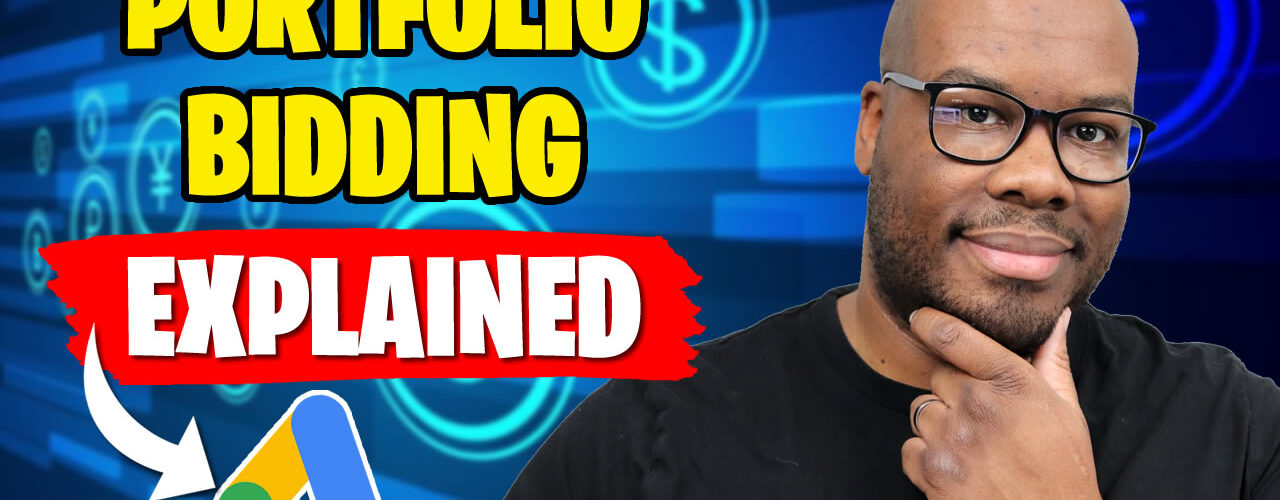Transcript – Get MORE CONTROL With Portfolio Bid Strategies
In today’s video, we are taking a look at portfolio bidding strategies, which is an advanced bidding strategy method in Google ads. It allows you to set your bid strategy at account level as opposed to at campaign level. But in addition to those differences, there are also some pretty major advantages of using a portfolio strategy over a normal strategy.
So in today’s video, I’m going to break down exactly what a portfolio bidding strategy. is what the advantages to using this type of strategy are to your campaigns. And at the end of the video, I’m going to do a tutorial where I share my screen and show you exactly how to set up your own portfolio bidding strategy.
So first of all, what do I mean when I say a portfolio bidding strategy? Well, it allows you to use Google’s smart bidding strategies at account level as opposed to at campaign level. So when you look at Google’s smart bidding strategy options available, you have maximize impression share or target impression share.
Should I say maximize clicks? You have maximized conversions and you have maximized conversion value where you can set a target CPA and target ROAS respectively. All of these smart bidding strategies are available as portfolio bidding strategies at account level. So why would you set your bid strategy at account level as opposed to at campaign level?
Well, there are some inherent advantages of doing this, including extra constraints that you can put onto your bidding strategies not normally available at campaign level. So stick around because This part gets really interesting. But the first advantage I want to share with you is the fact that with a portfolio bidding strategy, you can share both your bid strategy and your budgets across multiple campaigns.
So say for example, you have a bunch of campaigns in your account or trying to get to essentially. What is the same goal? Say the goal is a target CPA of 30 dollars. Each of those campaigns will have their CPA target and their bid strategy set at campaign level and their budget also set at campaign level.
If you were to transition to a portfolio strategy you would set the budget and bid strategy for all of those campaigns at account level within the shared library in Google Ads and Google will share that budget across all of your campaigns effectively and share the bid strategy as well. The main advantage to this is the fact that on days where a particular campaign might have a reduction in volume and another campaign might see an increase in volume, Google can distribute your budget effectively across all of those campaigns and also share the bid strategy as well.
So your campaigns are essentially working in unison from the same bid strategy and the same campaign budget as well. So it’s a great way to kind of streamline your account management and also get the benefit of that budget distribution without setting a separate budget and a separate bid strategy at campaign level.
But the main advantage I know you stuck around for is the fact that that you can do additional things not normally available at campaign level within your bid strategies, which are really, really cool. And I think by the end of this video, you are probably going to use them straight away. First of all, you can set a max CPC alongside a smart bidding strategy.
For example, if you’re running a campaign with maximized conversions with a target CPA at campaign level, you cannot cap the max CPC, even if you wanted to, but with a portfolio bidding strategy, you can, you can go in. create a portfolio bidding strategy, apply it to your campaign and set a target CPA in line with the target you want for your business.
But in addition to that, you can also set a max CPC as well. So yes, you can have the best of both worlds where you have your own controls over your CPCs, but also get to leverage Google’s smart bidding. But like anything in Google ads. There’s always a give and a take, an advantage and a disadvantage to any feature.
So let’s look at this in a bit more detail. First of all, the obvious use case for this is when you see your CPCs go absolutely crazy. Let me give you an example from one of my B2B clients. Now this particular client, some days where there’s less demand, Google goes absolutely crazy and increases the CPCs massively.
They are on a target CPA strategy and on the days it’s quiet when Google can’t. Utilize the budget effectively sometimes CPCs can be four or five times higher than what they normally would be in a period where Not even high demand, but just normal daily demand. So when one day I can look into the account, the average CPC will be about 4 5, and then another day in the account, the average CPC can be 20 25.
And on those days, those massive expensive clicks Just, just eviscerate the budget, there’s nothing left to spend on by the end of the day. And it just, it just doesn’t make sense. So what we did, we put a portfolio bidding strategy in place to ensure that we cap the CPC, meaning on days where there is less demand and Google wants to go crazy, it can’t.
So we’ve capped them and stopped them. So in this particular example, we were comfortable setting a max CPC bid of 9. To give Google enough room to get the clicks that are needed to get conversions because remember an Average CPC is an average there’s going to be clicks more expensive There’s going to be clicks that are cheaper And if you cap it too much You’re going to end up constraining your campaign too much and when you do this Google can give you a bid setting limited status on your campaigns, meaning your max CPC that you’ve set in your portfolio strategy is pulling back what the target CPA or the bidding strategy you’ve set can do.
And it won’t increase the CPCs in line with that strategy enough. In the example I just gave you for that B2B client, that’s fine. It also has a bid setting limited status, but we know we’ve given it enough wiggle room because the average CPC on a normal day is between four and five dollars. Giving it up to nine dollars gives it more than double what’s expected.
in order to reach the goals of the campaign. Costs are brought back in line and we don’t see days where we’re spending 25 for a single click when it’s not justified and Google just wants to burn through our budget. But conversely, you might go away and try this strategy and then set a max CPC bid in line with your target CPA and it’s too constrained and you get that status and you might listen to this video and think it’s okay because I’ve said it’s okay, but you might actually be hindering your campaign.
For example, if you’re getting a max CPC, generally speaking of 2 and you set your constraint at 2. Guess what? You have massively hindered your campaign. Don’t treat this like a max CPC bid. Treat it as a guardrail against Google going crazy. Set it a bit higher than you normally would. Don’t treat it like a manual CPC bid.
So now that you understand the advantages of a portfolio bidding strategy, let’s go ahead and set one up. Okay, so here I am in Google Ads and in order to set up a portfolio strategy, go to tools and settings and then under the shared library go to bid strategies. Once you’re in here, you just have to click this blue plus button to create a portfolio bid strategy.
And you can choose from all of the smart bidding options available in Google ads. In this example, I’m going to use target CPA because in the target CPA strategy, this is where you can set your constraints for max CPC. This option is not available in target ROAS. So we’re going to use target CPA for this example.
So here’s my portfolio strategy page. And I’m going to create the name, I’m going to call it target. CPA of 30 and max CPC of 5. It makes sense to name it in line with what the rule is because it’s easier to identify. Once you’ve given it a name, you need to select the campaigns it applies to. So i’ve selected the campaigns So there’s my account you have all your campaigns here.
All you need to do is tick the ones that apply I’m going to apply it to one campaign. You can do it to as many as apply to this particular strategy And hit done Now, once you’ve done that, you can set your target CPA as you normally would. So, let’s go with the target CPA of 30, as I mentioned. And underneath that, you have something called Advanced Options.
You can click Advanced Options, and this is where you set your max CPC bid limit. So, you can see your max CPC bid limit here, you can have a minimum bid and a maximum bid. Minimum bid doesn’t necessarily need to be used because it will only be used on the, sorry, bid limits won’t be used on the display network, but minimum bid limits, they’re not necessarily as important as your max bid limit, unless maybe you’re in a position where your campaigns aren’t getting visibility and you want them to bid higher, you can force Google to bid higher.
But in very, in all honesty, I don’t know when you would necessarily do that because your target CPA strategy is going to adjust the bids according to that goal. That goal is more important, but the maximum bid limit constraint is the part we need to look at here today. Because if you set your max bid limit, it means Google can’t go over this.
even though it’s working towards a target CPA. And remember what I said at the start of this video, if you set this bid limit too low, then your campaign will just not spend. If you set it high enough, it will give you room to spend, but also get clicks required to hit this CPA target. So I’m going to set the limit as mentioned as five pounds, as I mentioned at the beginning of this tutorial.
So that’s done. It’s a very simple thing to set up. That’s now applied to this campaign with this target CPA with this maximum bid limit and then all you need to do now is hit save.
And that’s it! It’s ready to go, it’s in place, and this will supersede the bid strategy at campaign level. And of course, as I mentioned, you might get that bid bidding limited status as a result of doing this, but as I say, if you give enough room away from your, your, your average CPC, you should be fine doing this.
Hire me as your PPC freelancer







